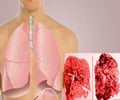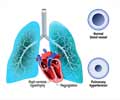Chronic obstructive pulmonary disease (COPD) is a lung condition that often affects cigarette smokers. The condition arises due to obstruction to the flow of air in the lungs. The affected people suffer from symptoms like chronic cough, wheezing, shortness of breath and limitation of activity in the later stages. COPD is of three types, emphysema wherein the lung sacs are destroyed, chronic bronchitis, wherein the large air passage ways are inflamed and small airway disease, wherein the small airways are affected.
Studies indicate that small airways are the major site of obstruction in patients with COPD.A study was carried out to study the relationship between the number and dimensions of small airways and emphysematous changes in the lungs. The number of small airways with a diameter of between 2.0 and 2.5mm were calculated using mutidetector CT scan in a total of 96 lungs, out of which 78 were from patients with varying degree of COPD, 4 from deceased patients and 14 from patients undergoing lung transplantation for Stage 4 COPD.
MicroCT was used to measure the average alveolar dimension, the number of terminal bronchioles per millimeter of lung volume, and the diameter and cross-sectional area of the terminal bronchioles. (Terminal bronchioles are the last part of the conducting airways, which finally divide into the respiratory bronchioles).
Histological sections of some lung tissues were also examined.
The study showed that the number of airways measuring between 2 and 2.5 mm in diameter per lung pair was progressively reduced with worsening stages of COPD. It was however unclear whether the decrease in diameter was due to reduction in the number of small airways or simply due to narrowing of the airways.
Lungs with COPD showed an 83 to 99.7% decrease in the terminal bronchiolar cross-sectional area per lung and a 72 to 89% reduction in the number of terminal bronchioles per lung depending on the type of emphysema. The narrowing and loss of terminal bronchioles seemed to precede the development of emphysema.
Reference:
Source-Medindia














